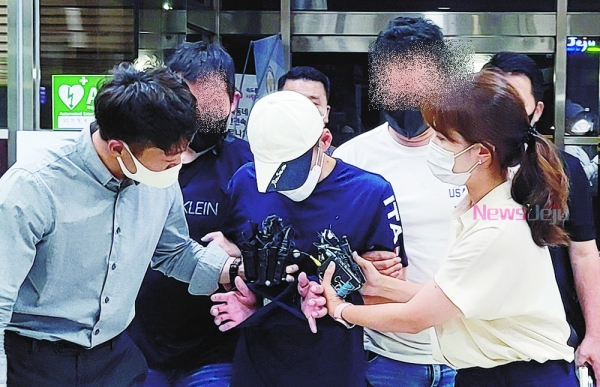
Due to a series of terrible crimes, including the stabbing at Sillim Station on July 21 and the knife rampage at Seohyeon Station on Aug. 3, the investigative agency decided to disclose the criminals’ personal information. There are four criteria for disclosure: whether the crime has caused cruel and serious damage, whether there is sufficient evidence, whether there is public interest such as crime prevention, and whether the suspect is a teenager or not. Since its implementation in 2010, a total of 74 cases have been subjected to deliberation, and 47 of them have been made public. However, the controversy over the disclosure of criminal information continues.
The first problem is that there is no clear standard. The two cases, the murder of a girlfriend in Sillim-dong four years ago and the murder of a cohabitant last year were opposed to whether to deliberate on the disclosure of personal information. The former did not disclose criminals’ personal information, saying it could violate human rights, and the latter was made public in the name of raising awareness of dating murders. According to the relevant laws, it is a structure in which the arbitrary judgment of the person who examines the identity as “can be made” only when all four of the above provisions are satisfied.
The second problem is that the difference between the photo released by the police and the current face is so large that it is ineffective. It is argued that the suspects of the incident at Sillim Station and Seohyeon Station, who revealed their personal information this time, are also very different from the actual appearance of the released photo. In the case of Korea, it is almost impossible to disclose a mug shot under the current law because it requires the consent of the suspect. According to the Korean National Police Agency (KNPA), when looking at the status of mug shots disclosure from 2010 to the Seohyeon Station incident, only one out of 13 cases has released mugshots. There must be a ground rule for the police to release the mug shot. However, the “Act on Special Cases Concerning the Punishment of Specific Violent Crimes,” which specifies the disclosure of the suspect's identity, does not have a regulation on mug shot shooting and disclosure. The media can film the suspect in the process of attending the court to undergo a warrant review, or the police sending the case to the prosecution and escorting the suspect. However, this also cannot be sanctioned if the suspect uses a hat, mask, or glasses to cover his/her face. Jun-Tae Lim, a Professor of the Department of Police Administration at Dongguk University, pointed out, “As the weight is focused on protecting the suspect, there is a lack of consideration for the victims, and it is not in line with the legal sentiment of ordinary citizens.”
In Korea, only felons’ identities are disclosed exceptionally, but many countries abroad disclose the identity of criminals in principle for the public’s right to know. In particular, the U.S. discloses mug shots if they are investigated as suspects in any crime. Recently, it was reported that mug shots were taken and released after an 8-year-old child was arrested for assaulting a teacher at an elementary school in Florida. Japan is also widely disclosing the identity of criminals. The practice of reporting real names when the media reports criminal cases has also been maintained for a long time.
Currently, various bills have been proposed to the National Assembly to expand the types of crimes that can be disclosed and to allow the latest photos of criminals to be released. According to the National Assembly’s bill information system, seven amendments have been proposed to the “Act on Special Cases Concerning the Punishment of Specific Violent Crimes”, which calls for disclosure of the suspect’s current description, not the past. Each revision calls for taking and releasing images within 30 days of the decision to disclose the suspect’s face or allowing photos and videos acquired or taken during the investigation if necessary. There is also content that prevents the suspect from covering his/her face with a mask even when he or she reveals his or her face. However, all the bills have not crossed the threshold of the standing committee, and it is impossible to predict whether they can pass the National Assembly due to opposition from human rights groups. The court is also cautious, saying that the investigative agency’s authority may become too excessive and affect the trial. Jae-hyun Seung, a senior researcher at the Korea Institute for Criminology and Justice (KICJ) said, “In the event of a violent crime, there is a victim. The bills must be passed to clearly show that the country is on the side of the victims.”



